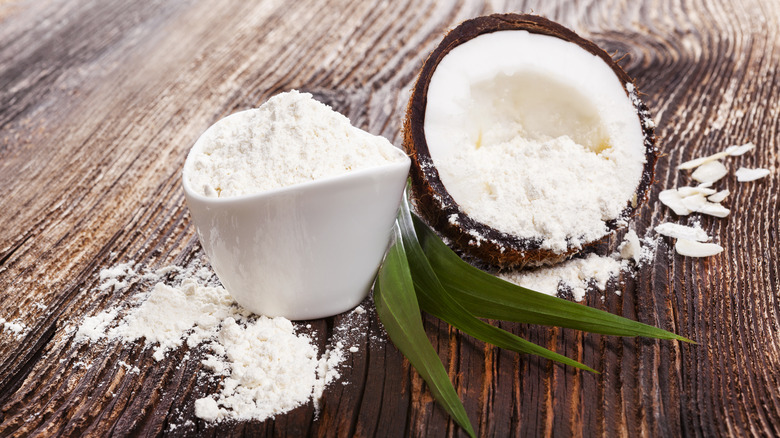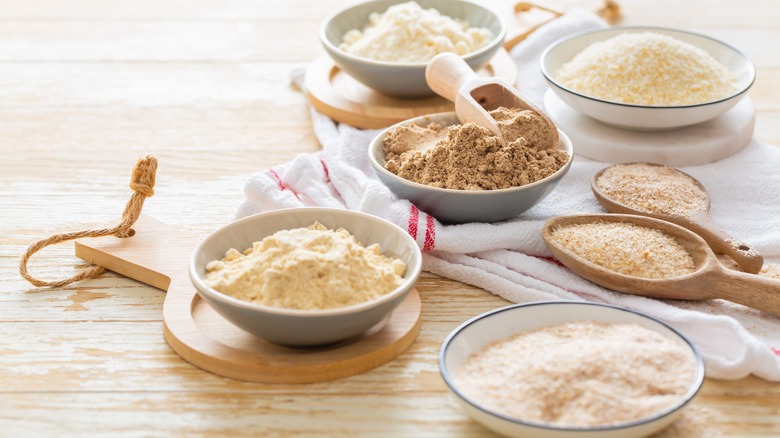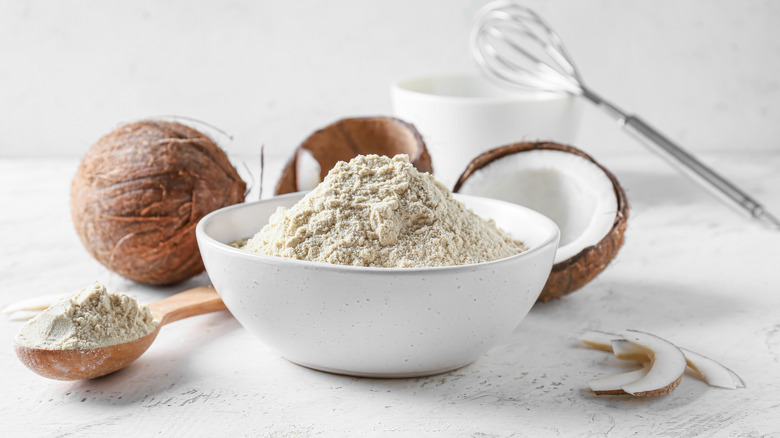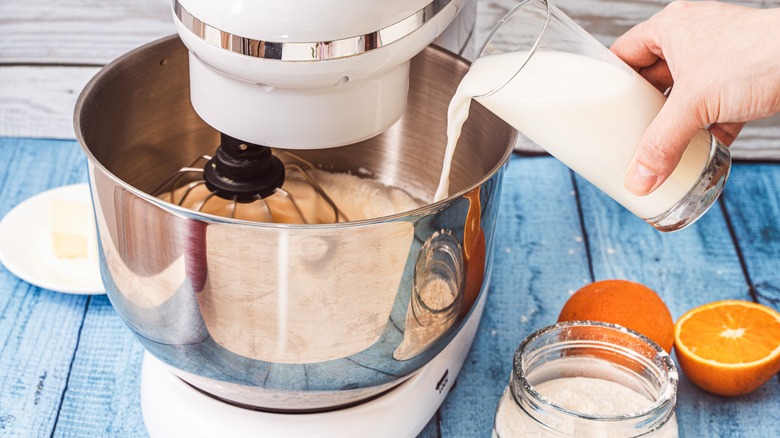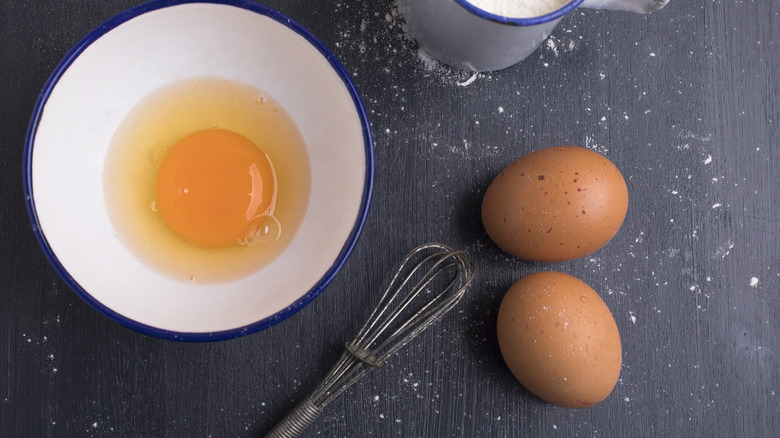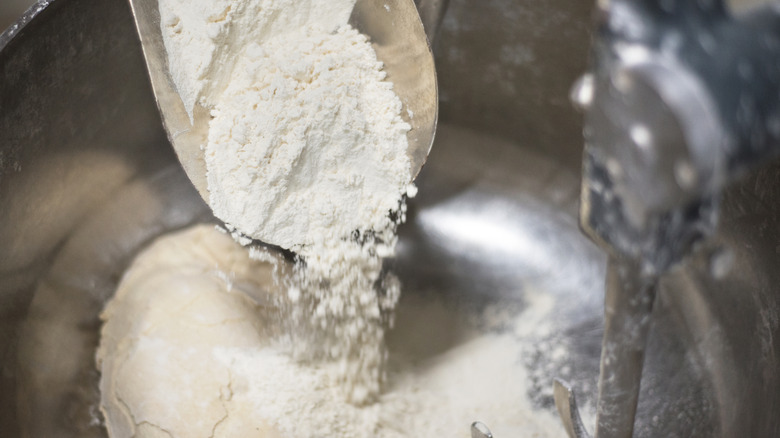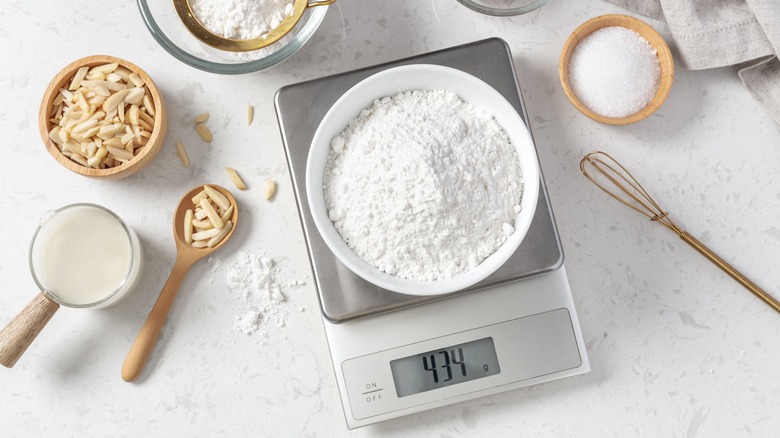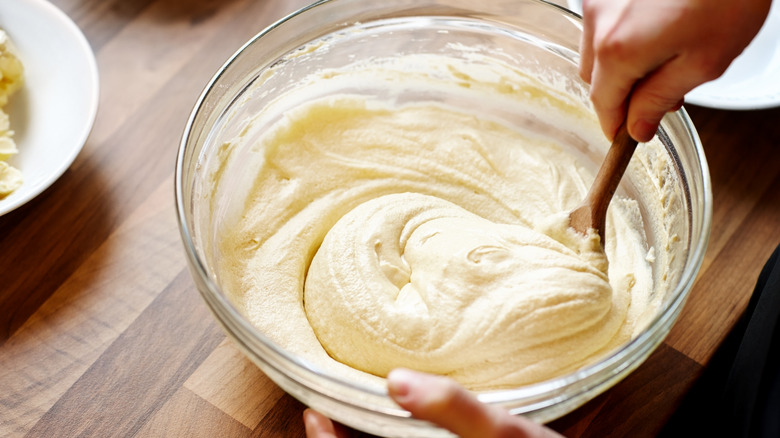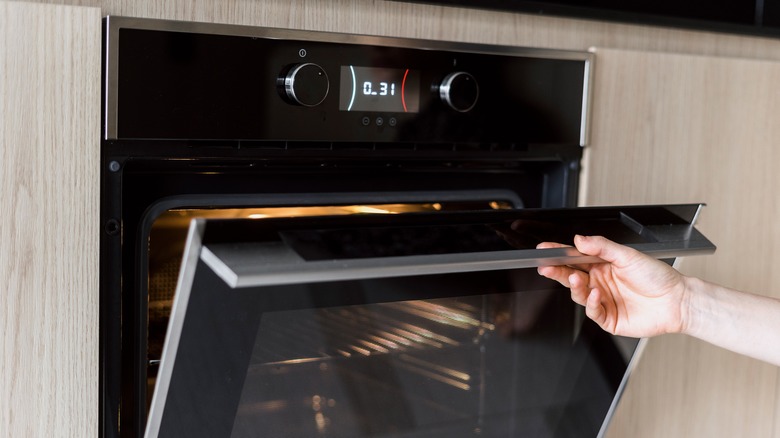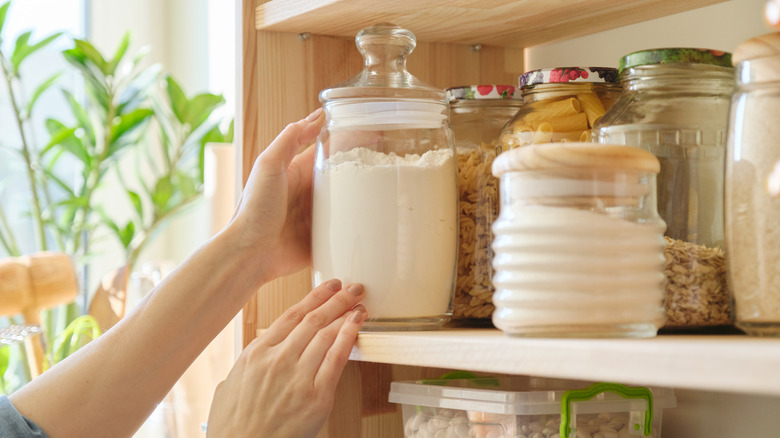10 Tips For Baking With Coconut Flour, From A Keto Recipe Developer
If you've ever dabbled in low-carb baking, attempted gluten-free snacks from scratch, or just have an affinity for the taste of coconut, you've likely come across coconut flour before. Subsequently, you've likely also experienced its unique and sometimes challenging nuances firsthand, as well as the fairly unpredictable results it can, at first, deliver. While it offers a unique texture and a subtle, delicious nutty flavor that enhances a wide range of recipes, coconut flour is somewhat of an unfavorable choice for bakes, given that it acts very differently than traditional wheat flour. However, when handled with care, and backed up by a little know-how, coconut flour can produce some of the best tasting, moreish low-carb and gluten-free goods, with an irresistible nuttiness and added sweetness that just can't be replicated by any other flour.
For expert advice on how to master the idiosyncrasies of this unique flour, we reached out to Carolyn Ketchum, experienced recipe developer behind All Day I Dream About Food and author of six keto cookbooks. Ketchum has extensive experience baking with coconut flour and frequently uses it to craft utterly moreish desserts. She provided us with her best tips for ensuring success with coconut flour. From adjusting liquid ratios to paying attention to tactile clues in your recipes, there are numerous crucial, but ultimately wholly simple, ways to accommodate for the distinct properties of coconut flour and thereby secure yourself perfectly formed and seriously delicious baked goods.
Don't expect it to act the same way as other flours
Much of coconut flour's somewhat controversial reputation comes from a misunderstanding of how it acts as an ingredient. This creates unrealistic expectations for how baked goods made with it will turn out. As recipe developer Carolyn Ketchum notes, "coconut flour is very different from regular wheat flour, but also different from nut-based flours and other gluten-free flours." For example, coconut flour reacts uniquely to liquids and thus requires an entirely different approach. When people make mistakes with coconut flour, and it subsequently doesn't produce the results they were expecting, they conclude that it simply does not work well — and may be put off from baking with it again.
On the contrary, when handled correctly, Ketchum assures us that coconut flour can produce some of the best low-carb or gluten-free bakes, with a nuanced and tasty flavor profile. But it's necessary to understand that it isn't like other flours that you may be used to. Its texture, taste, and overall behavior when combined with other ingredients, are unlike any other flour. So, it shouldn't be treated simply as a gluten-free or low-carb alternative for wheat flour. Instead, it's in a realm of its own. Keeping this in mind, and not being discouraged by less-than-favorable results from first attempts, puts you in the best position for cooking with coconut flour. You may need to bake with it a few times to get used to it.
Opt for recipes designed for coconut flour
Coconut flour behaves very differently than most other flours, so it's best to avoid simply trying to substitute it into recipes that are not designed for it. Carolyn Ketchum advises to instead "start with well-tested and well-loved coconut flour recipes," as the ingredients and quantities will be fine-tuned to coconut flour's unique properties. Trying to simply swap regular wheat flour, gluten-free flour, or even almond flour, for the same amount of coconut flour will not work. Not only do you need far less coconut flour in general, but coconut flour also requires assistance from other ingredients to give it with structure and stability. So, you'll likely need to rework an entire recipe should you want to convert the flour. While possible, this is something that should only be done once you've gained a fair amount of experience baking with coconut flour.
Ketchum recommends that beginners start with a simple recipe, like coconut flour pancakes, that's forgiving and rather easy to make. Coconut flour also lends itself well to cakes, muffins and breads, so try starting out with recipes for these treats that are specially crafted and tested with coconut flour in mind. Once you have a feel for the way that coconut flour behaves and reacts with other ingredients, you can, of course, start to experiment and veer out of tried-and-tested territory, but be wary that the bake still may not come out as you intended.
Take note of coconut flour's absorbency
Part of the reason why coconut flour cannot be substituted in equal parts for other flour is its sponginess. "Coconut flour is very absorbent," says Carolyn Ketchum, "and will soak up eggs, oils and liquids in an astonishing fashion." It's this porous quality that makes coconut flour a great choice for cakes and muffins, which typically contain more wet ingredients than bakes like cookies and pastries. Recipes that don't offer extra liquids have a propensity to dry out when made with coconut flour, since even a small amount can soak up a significant amount of fluid.
For this reason, coconut flour should typically be used sparingly and in much smaller quantities than its wheat-based counterparts. You should expect to use a 1-to-4 ratio of coconut flour to regular flour — so don't be surprised if a coconut flour-specific recipe calls for far less flour than you are used to. Incorporating additional liquids to cater for coconut flour's porosity may also be useful, but you'll also need to be careful so that your bakes don't end up too runny and lacking in structure.
Provide structure with eggs
A great way to accommodate coconut flour's absorbency and simultaneously offer your bakes more structure is to add eggs. Or, add more eggs than you'd typically use for your recipe.
You may notice a recipe made with coconut flour may call for more eggs than seems right. But, just know that they are, in fact, a crucial ingredient and have a very good reason for being there. Since coconut flour lacks gluten, eggs, particularly the proteins found in the whites, offer useful binding properties that help ensure your baked goods hold together. Additionally, the moisture in eggs helps to counteract coconut flour's ultra-absorbent nature, without thinning out a batter in the same way that adding copious amounts of extra liquids would.
Moreover, it's best not to substitute eggs for an alternative ingredient. Eggs have a unique composition that makes them the ideal binding ingredient, and Carolyn Ketchum notes that "if you try to skip the eggs or replace them with another ingredient like yogurt, coconut flour baked goods won't rise properly". She also adds that doing so may also cause bakes to "become mushy in the middle." Certain vegan alternatives, such as flaxseed or psyllium husk, may offer slightly better chances of success. But you'll need to be more mindful when baking with such substitutes, especially given coconut flour's distinctive characteristics.
Consider combining it with other flours
For improved consistency and a more subtle flavor, try combining coconut flour with other flours. This may balance its moisture-absorbing properties and density. If you're looking to keep things low-carb or gluten-free, almond flour offers itself as an excellent addition– especially in gluten-free tarts. Not only does almond flour, which contains a ton of moisture and fat, contribute a sweet and nutty flavor that perfectly complements the taste of coconut, but its composition makes it perfect for pairing with thirsty coconut flour. Carolyn Ketchum confirms that muffins and cakes in particular benefit from a combination of almond flour and coconut flour. Foe cakes, she shares that she typically uses 2 cups of almond flour for every ⅓ cup of coconut flour.
Coconut and almond both pair well with cocoa, making this combination ideal for a rich and nutty chocolate cake. It works equally as well with warming spices and flavors like cinnamon, like in our gluten-free almond coffee cake, which is made with both coconut and almond flour. However, almond flour is not the only option if you're looking to create a bake with multiple flours or offset some of coconut flour's more difficult characteristics. Hazelnut flour and cassava flour also work well alongside coconut flour, although the latter is higher in carbohydrates than nut-based alternatives, making it less suitable for keto or low-carb bakes.
Incorporate other flavors and spices to mute a strong coconut taste
Unlike wheat-based flours, which are essentially tasteless, coconut flour has a more distinctive flavor. Although it's fairly subtle after baking, its nonetheless noticeable, which is a factor that may be off-putting to some who don't wish to impart a coconut flavor to their bakes. Carolyn Ketchum notes, however, that the taste need not be at the forefront of your baked goods, and that you can "disguise it completely by using cocoa powder or vanilla extract." Other punchy spices, including cinnamon and cloves, may help to cover up traces of coconut. You may be able to shroud the taste of coconut flour even more so when creating savory recipes with it and pairing it with other bold ingredients, including herbs, such as rosemary, sage, or thyme, spices like paprika and chili powder, or strong cheeses for salty and sharp coconut flour crackers.
However, if you do, in fact, enjoy the taste of coconut, you can certainly heighten its sweet and nutty flavor by incorporating coconut flakes, desiccated coconut, or coconut milk into your recipe, being careful with quantities and keeping an eye on the batter's consistency. Each of these coconut-based ingredients add an extra element of texture and amplify the earthy and toasted flavor. Doubling or tripling the amount of coconut influence on your dessert will surely result in a truly moreish, tropical-tasting treat.
Consider using a kitchen scale if you're a beginner
Coconut flour has a reputation for being temperamental. However, like any ingredient, it shouldn't be too unpredictable — so long as you're careful and precise. Thus, a key factor in ensuring success when baking with coconut flour is to keep the measurements accurate. While all-purpose flour offers more leeway — meaning that you won't see too big of a difference if your measurements are a little off — coconut flour requires more attention to detail because of the way it interacts with other ingredients.
Generally, using cups to measure coconut flour and accompanying ingredients in your recipe is okay; just be sure to level off your ingredients using a knife or leveler after you scoop. Carolyn Ketchum confirms that she uses cups for measuring but notes that her extensive experience means that she is accustomed to ensuring accuracy when prepping her ingredients in this way. "If someone is having trouble, they should get a kitchen scale," she notes.
Baking with a scale is a surefire way to make sure that your measurements are correct, leaving far less room for error than cups and spoons. And, it's an especially good practice when you are cooking with coconut flour since you can be consistent. As such, if you practice trial and error with a coconut flour recipe, you can be sure that there are no discrepancies and can accommodate accordingly by adjusting the quantities of individual ingredients.
Pay attention to visual and tactile clues
A little flexibility is required when baking with coconut flour. Though your initial measurements should be precise and in line with a tried and tested recipe, achieving perfect results sometimes means making small adjustments until you have the consistency you're looking for. As Carolyn Ketchum points out, a good recipe should give you a clear idea of what the batter will look like. For example, a thick but easily spreadable batter is a common desirable texture for cakes. Paying attention to these visual clues, alongside your recipe's description of what you are ultimately aiming for, will help you decide whether or not you need to tweak the ingredients slightly.
When making adjustments, be sure to work in increments to avoid making irreversible changes to the thickness of your mix. "If your batter is too thick, add a little liquid 1 tablespoon at a time. If your batter is very thin, add another tablespoon of coconut flour," instructs Ketchum. This hands-on approach is not only instrumental in ensuring the success of an individual recipe but can also help you gain familiarity with the nuances of coconut flour and the way it reacts to wet and dry ingredients, which will in turn make future endeavors that little bit easier. You'll likely want to use the same liquids that are already included in your recipe; almond milk, coconut milk, or even simply water are all fairly solid choices for thinning your batter.
Keeping baking times and temperatures largely consistent
Although coconut flour behaves very differently from regular flour in many respects, it does, in fact, actually bake at similar temperatures and in similar time frames. This means that you can, in theory, incorporate coconut flour into existing recipes without needing to make significant adjustments to your oven settings. Though this should, of course, come after a period of practicing. Carolyn Ketchum tells us that coconut flour typically bakes in the range of 325 F to 375 F, so there's no need to crank the heat right up, or conversely keep it needlessly low and gentle, which will just have you waiting around far longer than is necessary. It may brown a little quicker on top, but using a thermometer, inserting a skewer into the bake and checking it comes out clean, or even simply looking to see if your bake has risen properly if applicable, can help you monitor its progress and ensure your goods do not overcook.
Ketchum continues to explain that, just like with regular flour, "you need a blast of heat to get items to rise" — which is essential to ensure a light and airy texture. A correctly preheated oven will give that burst of heat that will prompt your bakes to rise up while the structure sets, preventing it from sinking halfway-through baking.
Be sure to store it correctly
Although coconut flour does not spoil notably quickly or easily, proper storage is necessary to ensure its effectiveness and longevity. Its high-fat content and oily nature, which can make it go rancid in the heat, makes it more perishable than its wheat-based counterparts. Moreover, its super absorbent properties put it at risk of becoming damp and clumpy if it comes into contact with moisture, which can in turn make it trickier to sieve and to bake with. Carolyn Ketchum told us that "[coconut flour] should be kept in a cool location in an airtight container." Ketchum also recommends storing coconut flour in a pantry, as opposed to keeping it in the fridge. The condensation in the fridge may result in spoiled and clumpy flour.
When stored correctly, in dry and cool conditions and sealed tightly, coconut flour can last up to 18 months. It should retain a fine, dry, and crumbly texture that yields reliable results each time. Coconut flour that has gone bad is easy to spot — and is even easier to smell. Given that its natural aroma is light, sweet, and floral, any coconut flour that smells musty or sour is most likely past its prime and should be discarded.
